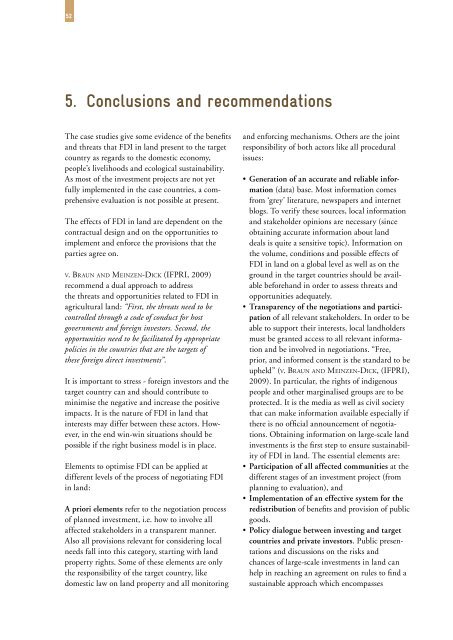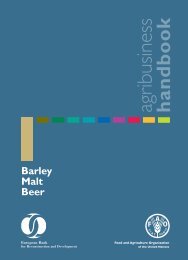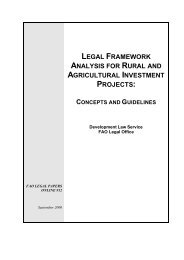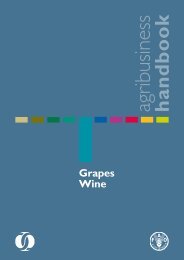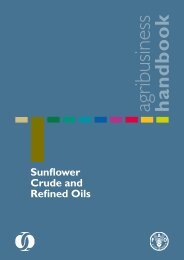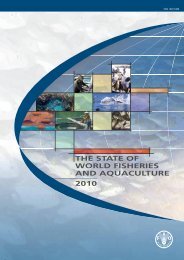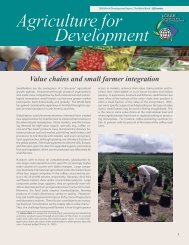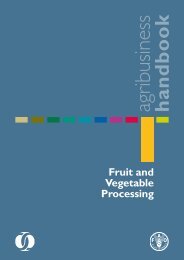Foreign Direct Investment (FDI) in Land in developing countries
Foreign Direct Investment (FDI) in Land in developing countries
Foreign Direct Investment (FDI) in Land in developing countries
- No tags were found...
You also want an ePaper? Increase the reach of your titles
YUMPU automatically turns print PDFs into web optimized ePapers that Google loves.
525. Conclusions and recommendationsThe case studies give some evidence of the benefitsand threats that <strong>FDI</strong> <strong>in</strong> land present to the targetcountry as regards to the domestic economy,people’s livelihoods and ecological susta<strong>in</strong>ability.As most of the <strong>in</strong>vestment projects are not yetfully implemented <strong>in</strong> the case <strong>countries</strong>, a comprehensiveevaluation is not possible at present.The effects of <strong>FDI</strong> <strong>in</strong> land are dependent on thecontractual design and on the opportunities toimplement and enforce the provisions that theparties agree on.v. Braun and Me<strong>in</strong>zen-Dick (IFPRI, 2009)recommend a dual approach to addressthe threats and opportunities related to <strong>FDI</strong> <strong>in</strong>agricultural land: “First, the threats need to becontrolled through a code of conduct for hostgovernments and foreign <strong>in</strong>vestors. Second, theopportunities need to be facilitated by appropriatepolicies <strong>in</strong> the <strong>countries</strong> that are the targets ofthese foreign direct <strong>in</strong>vestments”.It is important to stress - foreign <strong>in</strong>vestors and thetarget country can and should contribute tom<strong>in</strong>imise the negative and <strong>in</strong>crease the positiveimpacts. It is the nature of <strong>FDI</strong> <strong>in</strong> land that<strong>in</strong>terests may differ between these actors. However,<strong>in</strong> the end w<strong>in</strong>-w<strong>in</strong> situations should bepossible if the right bus<strong>in</strong>ess model is <strong>in</strong> place.Elements to optimise <strong>FDI</strong> can be applied atdifferent levels of the process of negotiat<strong>in</strong>g <strong>FDI</strong><strong>in</strong> land:A priori elements refer to the negotiation processof planned <strong>in</strong>vestment, i.e. how to <strong>in</strong>volve allaffected stakeholders <strong>in</strong> a transparent manner.Also all provisions relevant for consider<strong>in</strong>g localneeds fall <strong>in</strong>to this category, start<strong>in</strong>g with landproperty rights. Some of these elements are onlythe responsibility of the target country, likedomestic law on land property and all monitor<strong>in</strong>gand enforc<strong>in</strong>g mechanisms. Others are the jo<strong>in</strong>tresponsibility of both actors like all proceduralissues:• Generation of an accurate and reliable <strong>in</strong>formation(data) base. Most <strong>in</strong>formation comesfrom ‘grey’ literature, newspapers and <strong>in</strong>ternetblogs. To verify these sources, local <strong>in</strong>formationand stakeholder op<strong>in</strong>ions are necessary (s<strong>in</strong>ceobta<strong>in</strong><strong>in</strong>g accurate <strong>in</strong>formation about landdeals is quite a sensitive topic). Information onthe volume, conditions and possible effects of<strong>FDI</strong> <strong>in</strong> land on a global level as well as on theground <strong>in</strong> the target <strong>countries</strong> should be availablebeforehand <strong>in</strong> order to assess threats andopportunities adequately.• Transparency of the negotiations and participationof all relevant stakeholders. In order to beable to support their <strong>in</strong>terests, local landholdersmust be granted access to all relevant <strong>in</strong>formationand be <strong>in</strong>volved <strong>in</strong> negotiations. “Free,prior, and <strong>in</strong>formed consent is the standard to beupheld” (v. Braun and Me<strong>in</strong>zen-Dick, (IFPRI),2009). In particular, the rights of <strong>in</strong>digenouspeople and other marg<strong>in</strong>alised groups are to beprotected. It is the media as well as civil societythat can make <strong>in</strong>formation available especially ifthere is no official announcement of negotiations.Obta<strong>in</strong><strong>in</strong>g <strong>in</strong>formation on large-scale land<strong>in</strong>vestments is the first step to ensure susta<strong>in</strong>abilityof <strong>FDI</strong> <strong>in</strong> land. The essential elements are:• Participation of all affected communities at thedifferent stages of an <strong>in</strong>vestment project (fromplann<strong>in</strong>g to evaluation), and• Implementation of an effective system for theredistribution of benefits and provision of publicgoods.• Policy dialogue between <strong>in</strong>vest<strong>in</strong>g and target<strong>countries</strong> and private <strong>in</strong>vestors. Public presentationsand discussions on the risks andchances of large-scale <strong>in</strong>vestments <strong>in</strong> land canhelp <strong>in</strong> reach<strong>in</strong>g an agreement on rules to f<strong>in</strong>d asusta<strong>in</strong>able approach which encompasses


